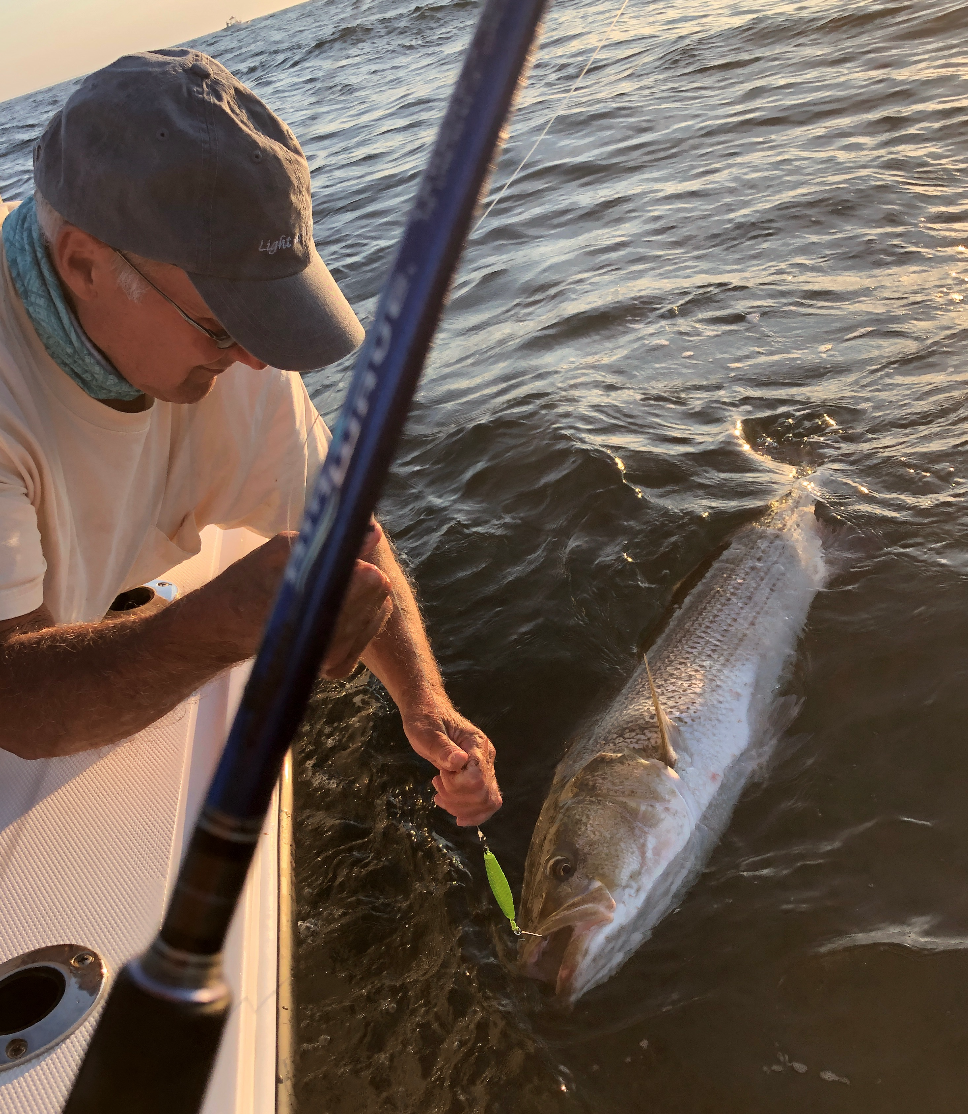How to Throw Back a Fish
How to Throw Back a Fish
Catch-and-release can be kill-and-waste if you’re not careful
By Paul Greenberg, Writer in Residence
A too-big striped bass is brought boat-side for release. Photo by Carl Safina.
Sometimes I wish that the fish on the end of my line was the one that got away. Take a night earlier this month. It was the full moon out in Montauk, Long Island, a time and place which east coast anglers know is a nearly unbeatable combination. The strong moon tides stimulate something in striped bass and the roiling rips off Montauk tumble prey in such a way that makes a striper feeding frenzy something of an inevitability.
But here’s the regulatory rub. The sportfishing community has been overfishing striped bass for the last decade at least; overfishing being defined as catching and killing more fish than can be replaced by the breeding population in a given period of time. Part of the reason overfishing has persisted is the tendency of anglers to high grade their catch. Since the per person limit on stripers is now just one fish, anglers got in the habit of releasing smaller fish until they got their hands on a “BOFFF” — a big old fat female fish as fisheries biologists sometimes call the largest and most fecund members of a given species. Soon we were losing BOFFFs too quickly and the stock was plummeting.
How then to protect the BOFFFs? Enter something called a “slot limit.” A slot limit makes keeping a fish below a certain size and above a certain size a no go. For striped bass a slot fish must be no smaller than 28 inches and no bigger than 35. The idea being that if you protect the big fish you shore up the breeding potential of the stock. This has worked extremely well in the Maine lobster fishery. In 1933, Maine fisheries commissioner Horatio D. Crie pushed through a new “double-gauge” law, prohibiting the taking of both very small and very large lobsters — essentially a slot limit. Just prior to the law’s enactment, Crie promised, “If a double gauge measure is passed … you will see the lobsters continue to increase from year to year. No one will ever have to feel disturbed about the depletion of the lobsters on the Maine coast.” This has proved true. There are now more lobsters being caught in Maine than ever in the state’s history.
Is the striped bass slot regulation, now nearly two years old, working? Too early to say. But what I can tell you is that on the full moon tide off Montauk this summer there were more 30 and 40 pound fish hitting our diamond jigs than we knew what to do with. Drop a jig. Bam! An epic battle and a massive striped bass. Indeed, one fish was so big that it just kept going until it had taken nearly all my line. After several hundred yards it popped off and continued on to the horizon.
But what to do about all those big fish that didn’t get away? Here is the conservation dilemma right now. Because if anglers endlessly and carelessly pick through dozens of big striped bass looking for their one 28"–35" “slot fish” a lot of damage can be done along the way. Unlike undersized and oversized lobsters which can easily be plucked from a trap and returned to the water with little damage, a big, powerful striped bass needs careful attention if she’s to maintain her awesome spawning status. Here then are a few rules anglers should keep in mind when releasing a fish:
Keep the fish in the water. How would you feel if someone took you out of the medium that allows you to breath? Not being able to get access to oxygen is incredibly stressful. If you can remove the hook while the fish is swimming boat side this is ideal.
Don’t touch. Fish are covered with a mucus layer that protects them from disease. Handling fish dings up that protection and opens a fish up to post-release infection.
No pictures please. OK, a photo while the fish is in the water is probably fine, but hoisting in and exposing the fish’s eyes to sunlight can cause lasting damage to their corneas.
Use the right hook. Pinch down barbs on hooks if you think you’ll have to be releasing fish. If using bait, use “circle” hooks that are more apt to catch in a fish’s jaw rather than in their gut. Remove treble hooks from lures and replace them with single barbless hooks if possible.
Think about stopping. The process of landing a fish is often described in fishing magazines as a “battle”, as if the two sides of the struggle are evenly matched. But let’s face it, a fish is no match for a human. They’re literally fighting for their lives.
Which is why as afternoon eased into early evening and the big striped bass at Montauk kept on biting we had to make a decision. Our instincts left unchallenged would have kept us fishing long into the night. Our logic, hard to unearth during a feeding frenzy, had to be summoned. Having caught our slot limit fish we decided to pack it in.
We humans came into this world as predators. It is not unnatural for us to kill for our food. But it isn't at all natural to torture fish with endless battles and days-long sessions of catch-and-release.
In the end if we want to have self-caught fish for dinner, instead of catch-and-release the most responsible policy might be kill and go home.

